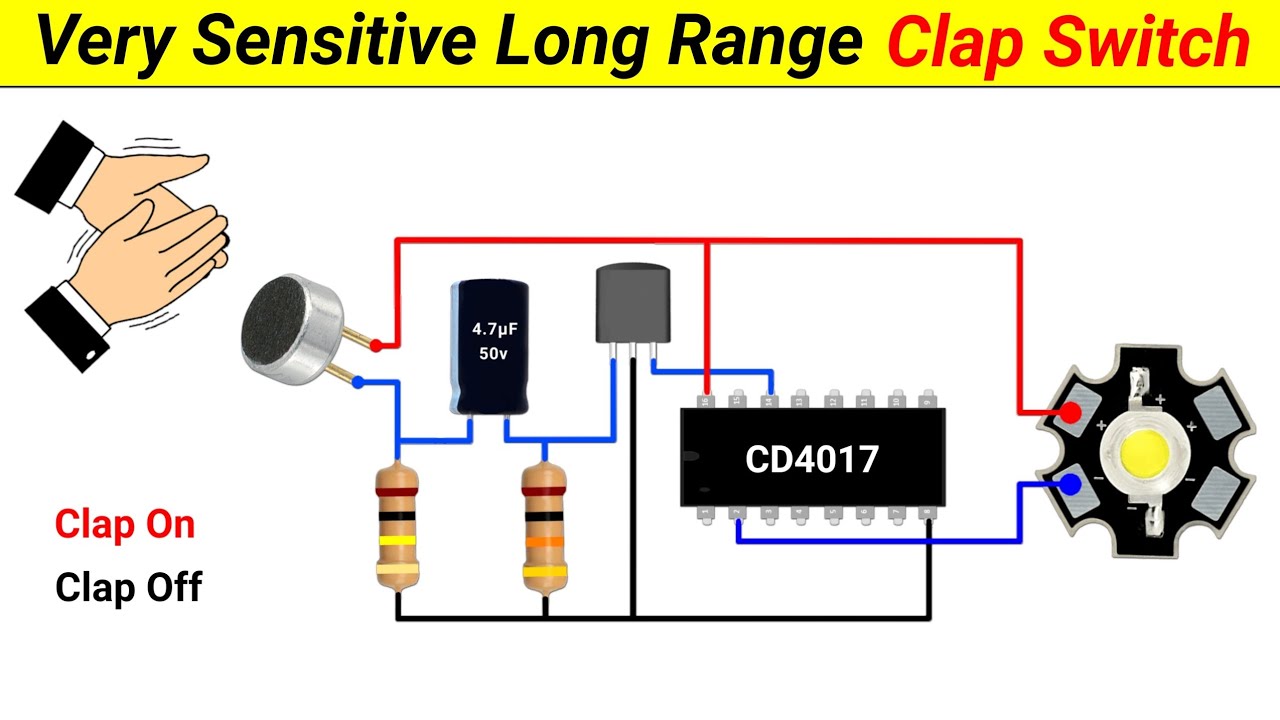Sound Reactive LED Circuit Using LM358 Op-Amp and Mic
Summary
TLDRThis video tutorial guides viewers on constructing a sound-reactive LED circuit. It explains the theory behind the circuit, detailing the function of each component including voltage dividers, an op-amp, feedback resistor, diode, and capacitor. The video also covers the step-by-step assembly process, emphasizing the importance of a condenser microphone to detect sound and trigger the LED. The goal is to create a circuit that lights up the LED in response to sound.
Takeaways
- 🎵 The video demonstrates how to create a sound-reactive LED circuit.
- 📚 It explains the theory behind the circuit and the purpose of each component.
- 🔊 The LED turns on in response to sound, as shown by the presenter speaking.
- 👍 The video encourages viewers to like and subscribe for more content.
- ⚡ Voltage dividers are used extensively in the circuit to regulate voltage levels.
- 🔗 A voltage divider is created by two resistors in series, explained with an example.
- 🔄 The script references another video on Ohm's law for further understanding of series and parallel circuits.
- 🔌 The first step in building the circuit involves connecting specific pins to the positive and negative rails.
- 🔄 A feedback resistor is used for negative feedback in the op-amp circuit.
- 💡 A diode is used to drop voltage when there is no sound, ensuring the LED turns off.
- ⏲️ A capacitor is included to filter out noise and prevent the op-amp from getting confused by extraneous signals.
- 🔋 The circuit is designed to work best with a 5-volt battery supply.
- 🎤 A condenser microphone is used to detect sound, changing its capacitance based on the sound it receives.
- 🔧 The final circuit allows sound signals to be processed and the LED to react accordingly.
Q & A
What is the main purpose of the video?
-The main purpose of the video is to demonstrate how to make a sound-reactive LED and explain the theory behind its operation.
What is a voltage divider and how is it used in the circuit?
-A voltage divider is a circuit with two resistors in series that creates a smaller voltage at its node by combining positive and negative voltages. It is used in the circuit to drop the voltage at specific points.
Why are there many voltage dividers in the circuit?
-There are many voltage dividers in the circuit because they help to regulate and adjust the voltage levels where needed, which is essential for the proper functioning of the circuit.
What is the role of the operational amplifier (op-amp) in the circuit?
-The operational amplifier (op-amp) takes two input voltages (inverting and non-inverting) and produces an output. It is used to amplify the difference between the two input voltages.
How is the voltage divider formed with resistors?
-The voltage divider is formed by connecting a 10 kilo ohm resistor between pin 3 (non-inverting input) and the negative rail, and another 10 kilo ohm resistor from pin 3 to the positive rail.
What is the purpose of the feedback resistor in the circuit?
-The feedback resistor, which is a high resistance resistor, provides negative feedback to the op-amp. It is connected between the inverting input and the output to stabilize the circuit.
Why is a diode used in the circuit?
-A diode is used to drop the voltage when there is no sound, ensuring the LED turns off. The diode's characteristic of dropping voltage when current runs through it is utilized here.
What is the function of the capacitor in the circuit?
-The capacitor, specifically a 0.47 microfarad capacitor, is used to filter out excess noise from the signal, preventing it from confusing the op-amp.
How is the LED connected in the circuit?
-The LED's negative (cathode) is connected to the diode, and its positive (anode) is connected to the positive rail through a 270 ohm resistor.
What is a condenser microphone and how does it work?
-A condenser microphone changes its capacitance based on the sound it receives. When it receives sound, the capacitance increases and this change is sensed by the circuit.
How does the sound signal travel through the circuit?
-Sound signals enter through the condenser microphone, get regulated by the voltage divider, filtered by the capacitor, and then travel through the feedback resistor to the op-amp, where it is compared and ultimately controls the LED's state.
Outlines

此内容仅限付费用户访问。 请升级后访问。
立即升级Mindmap

此内容仅限付费用户访问。 请升级后访问。
立即升级Keywords

此内容仅限付费用户访问。 请升级后访问。
立即升级Highlights

此内容仅限付费用户访问。 请升级后访问。
立即升级Transcripts

此内容仅限付费用户访问。 请升级后访问。
立即升级浏览更多相关视频

Light Sensor circuit on Breadboard + Darkness Detector | LDR & Transistor Projects

2023 Arduino Tutorial for Beginners 07 - Digital Output 02 - Build a LED Circuit

How to Make an Automatic Emergency Light || Power Failure Backup Light

Program Arduino Lampu Kedip Secara Online Gunakan WOKWI Tutorial DIY @tptumetro

How to make a Clap Switch || using 4017 IC || Very Sensitive Clap Switch || Science Project

Beginner Electronics - 8 - First Circuit!
5.0 / 5 (0 votes)
